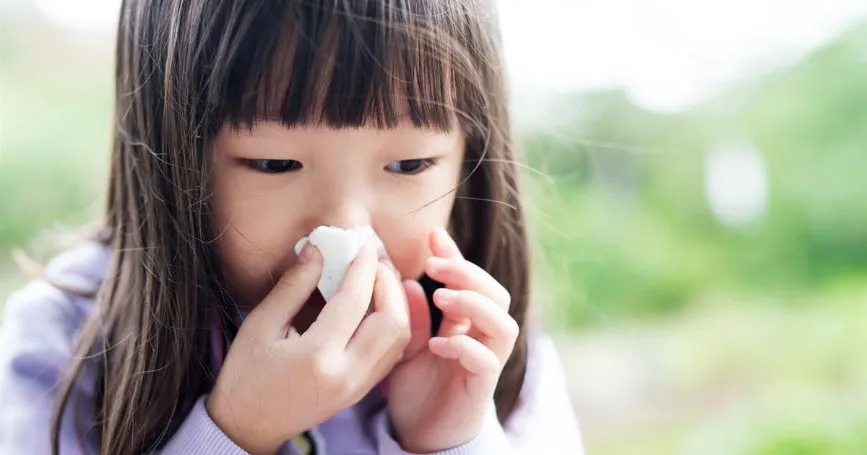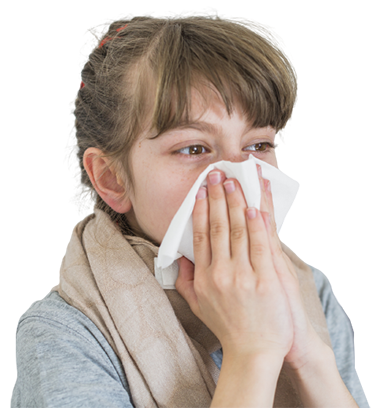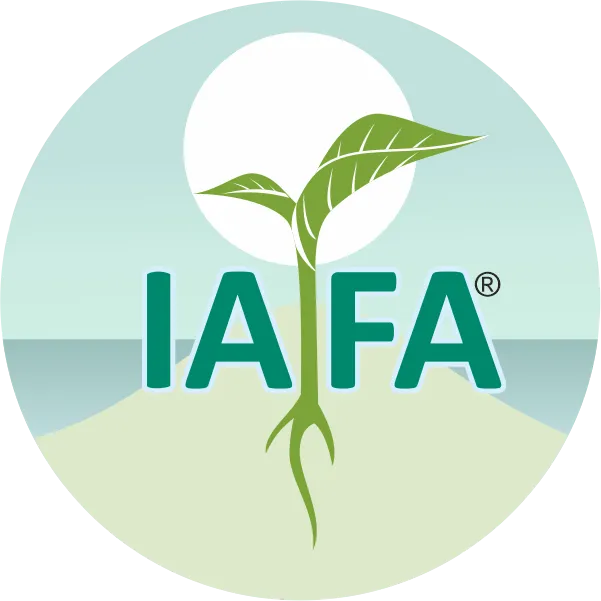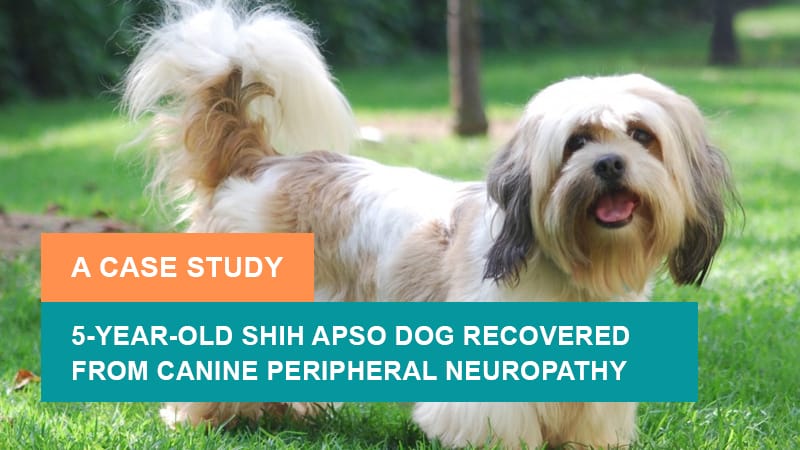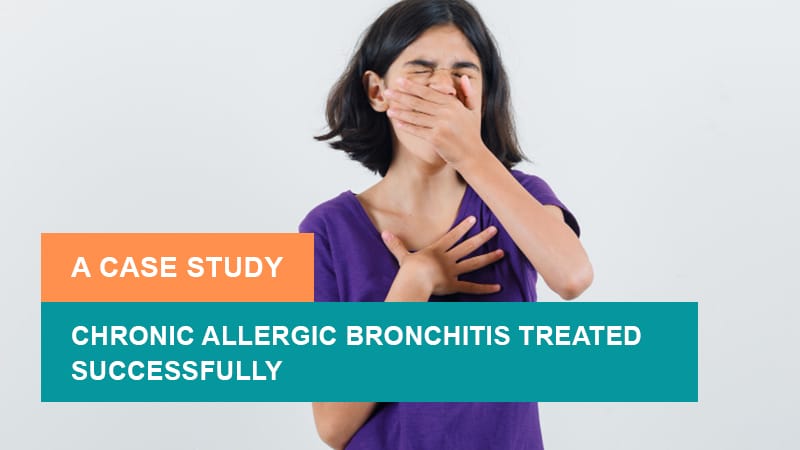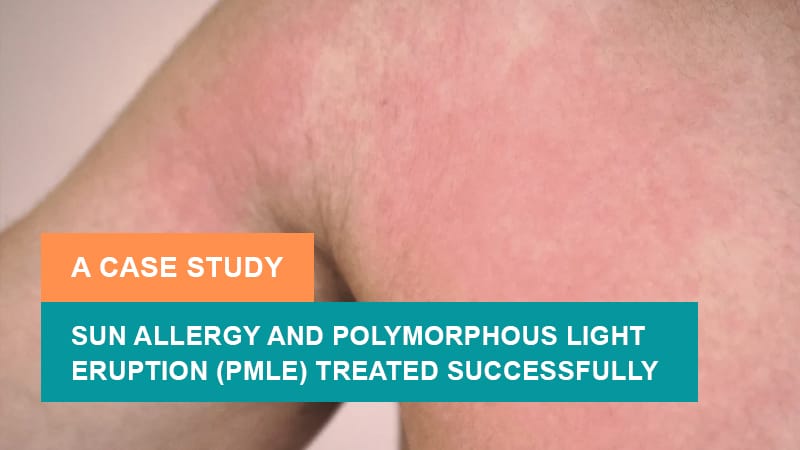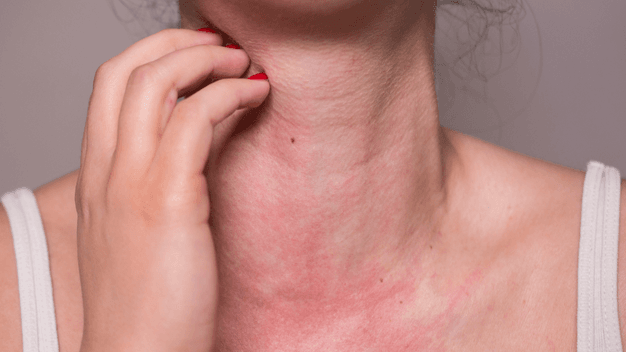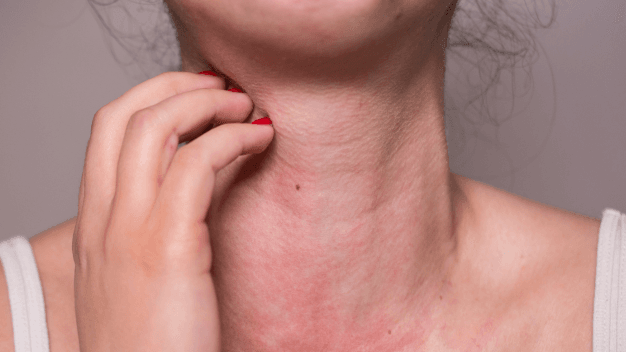On This Page
Overview
About Allergic Disease in Children
व्यधिक्ष्मत्वं नाम व्याधिबलविरोधित्वं व्यध्युत्पदादक प्रतिबन्दकत्वं ll
Allergic diseases in children have increased significantly in recent years and now affect up to 35% of children. They are a major cause of morbidity in children. Although there is a genetic predisposition, it is the exposure to environmental allergens, irritants and infections that will determine the sensitization to different dietary and inhalant allergens. Atopic dermatitis (AD), IgE-mediated food allergies, asthma and allergic rhinitis are often interrelated. They can coexist, or as one condition improves, another can evolve (‘the allergic march’). The capacity to prevent and treat allergic diseases depends on an understanding of the immunology that underlies the development and expression of allergic diseases, as well as an understanding of the environmental factors that promote their development.
Causes of Allergic Disease in Children
Allergic diseases are mostly caused by inhalant allergens, in particular mold and pollens, climate changes, food allergies, asthma etc.
Clinical Features of Allergic diseases in Children
Most common allergies dealt with the Children include:-
Food Intolerance (nonimmunological reactions)
The majority of adverse reactions to foods are mediated by non-immunological mechanisms. The most important cause of food-related reactions is toxic or microbial contamination.
Metabolic reactions are mainly due to problems in digesting carbohydrates, especially lactose, and involve symptoms related to the gastrointestinal tract (diarrhea, abdominal bloating and cramping)
Food Allergies (immunological reactions)
The prevalence of IgE-mediated food allergies is unknown and appears to be anywhere between 3% and 7.5%; the higher frequencies usually occurring in younger children. One and one-half per cent of infants will experience milk allergy during the first year of life. Of those children, 15% will retain their sensitivity into their second decade of life, and 35% will have allergies to other foods. Egg allergy is believed to affect about 1.3% of children, and peanut allergy about 0.5% of children.
Genetic predisposition, the allergenicity of food and the timing of exposure will determine the foods to which the atopic child develops allergy. A wide variety of foods have been reported to trigger anaphylaxis, with peanut, tree nuts, fish, seafood, egg and milk being the most frequently encountered food allergens. Food antigens may be hidden in foods and may not be readily identifiable.
Atopic Dermatitis
Atopic dermatitis usually begins during early infancy and affects about 10% of the paediatric population. It is a complex, chronic, inflammatory skin disorder that is characterized by severe pruritus, a chronically relapsing course, classic skin distribution and other diagnostic criteria. Atopic dermatitis appears before one year of age in 60% and within five years in 85% of those who are destined to acquire it.
Asthma
The main causes of asthma appear to be early viral infections, exposure to cigarette smoke and atopy. Viral infections have also been shown to increase hyper responsiveness and have also been associated with acute exacerbations of asthma in children. The level of IgE to Respiratory syncytial virus infection has been associated with an increasing severity of bronchospasm and hypoxia. Persistent wheezing after Respiratory syncytial virus infection in infancy is short lived in the absence of other factors such as atopic family history or exposure to cigarette smoke
Allergic Rhinitis
Allergic rhinitis is a major cause of morbidity in children. It is the cause, coexisting disorder or predisposing factor in many cases of serous otitis, chronic sinusitis, increased susceptibility to upper and lower respiratory infections and orthodontic disorders such as overbite and maldeveloped dental arches. Many children who suffer from allergic rhinitis present with a chronic congested nose or recurrent upper respiratory infections and are repeatedly treated with cold medications and/or antibiotics.
Ayurvedic View on Allergic Disease in Children
According to Ayurveda the lifespan of an individual is divided into three parts known as Vaya. These are,
- Balavastha (childhood), which lasts up to the age of 16 years
- Madhyavastha (young and middle age), which lasts from the age of 16 years to 60–70 years and
- Vriddhavastha or Jirnavastha (old age), which refers to the period after 60 or 70 years
Ayurveda also incorporates both the preventive and curative aspects of human ailments and all the aspects resembles to the entire function of Vyadhikshamatva or immune power of a body.
Ayurvedic Reference of Allergic Disease in Children
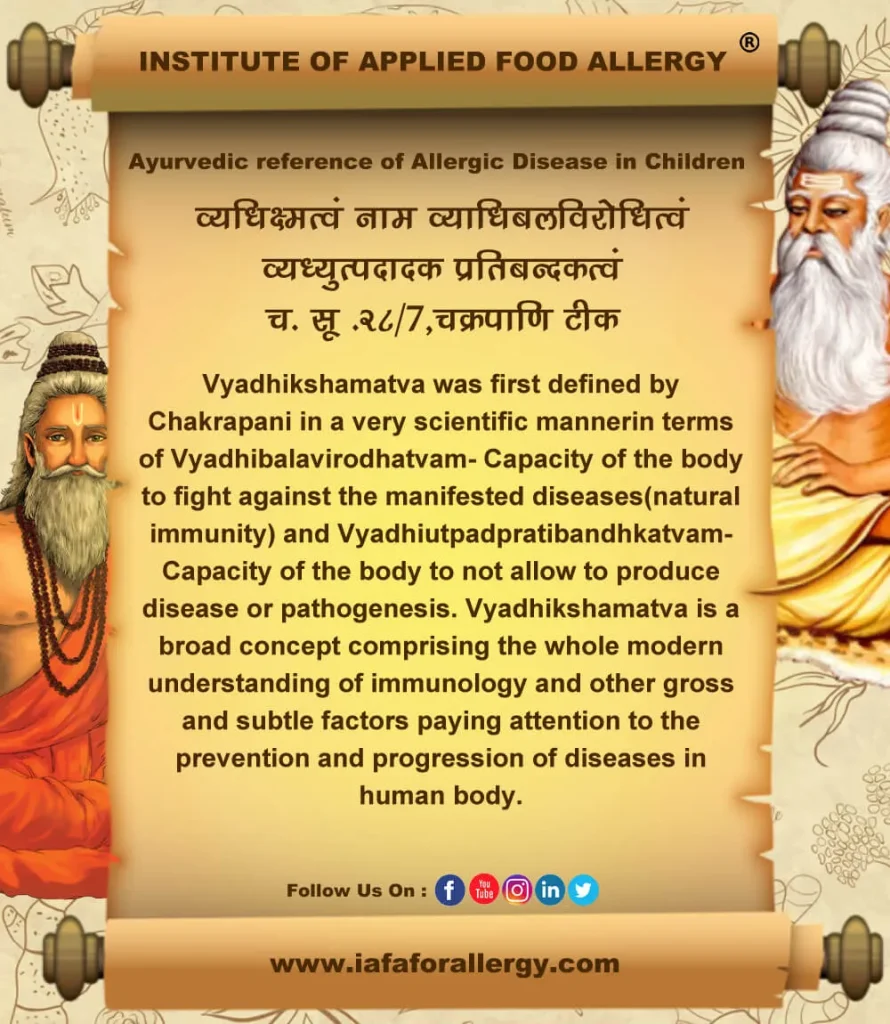
Vyadhikshamatva merely depends upon the strength or Bala of an individual which is categorized into three as, Sahaja Yukthikritha and Kalaja Bala. Sahaja is the one we get from our birth itself, Yukthikritha is the one which is acquired during one’s own life. Kalaja Bala refers to the strength which is influenced by the age of the person and seasonal changes. Bala in turn depends on the ultimate essence of the body-Ojas and it keeps the vitality of the body
Usually in children, due to immaturity and diminution of body components, there will be reduced strength in the body, which leads to a lower level of Vyadhikshamatwa. Thus they are more susceptible to diseases. Whereas, contrary to this, youth, due to maturity and proper nourishment, will have normal strength and thus normal vyadhikshamatwa also.
So in every disease occurring in children, it depends upon the Vyadhikshamatva of the individual and so is the allergic diseases also. Due to the weakening of immune system as age progresses, it will be difficult to attack all the foreign bodies invading the body.
Ayurveda recommends both preventive and curative aspects of treatment for allergic diseases in Children.
Preventive Aspects
For this Ayurveda strongly advices that the rules related to the deeds and sequence of daily routine (Dincharya), diet and behavior related rules for different seasons of the year (Ritucharya) and behavioral etiquettes for being wise, active and peaceful person (Sadvritta) should be followed.
Therapeutic Aspect
All the disorders in children, elderly, and pregnant women are difficult to treat according to Ayurveda. Especially diseases in elderly can only be managed; they can rarely be cured completely. As every disease in elderly has to be treated with holistic approach, Ayurveda can prove a very rich resource of safe drugs with multidimensional effects for various chronic, debilitating disorders.

“Dr. Gupta’s IAFA is committed to deliver excellence in health care with care and compassion. Institute of Applied Food Allergy® provides outstanding treatment for all Allergic Diseases in Children”.
Your health. Our mission!!! Reach Dr. Gupta’s IAFA for all worries about your Children’s health.
– Dr. Sahil Gupta (B.A.M.S., M.H.A.)
Ayurvedic Allergy Specialist
CEO & Founder of IAFA®
At last, Easier Allergic Diseases in Children Management

Trusted by
More than 90,000 Patients

Convenient
at-Home Treatments

9.2 / 10
Customer Satisfaction Score
Ayurvedic Treatment for Allergic Diseases in Children
Ayurveda offers various classical ayurvedic formulation as mentioned below for natural treatment of Allergic diseases in Children.
Internal Medicines for Allergic diseases in Children
- Haridra khanda
- Taleesadi churna
- Dashamoolakatutrayadi Kashaya
- Bharangyadikwatha
- Indukantham kashayam
- Guluchyadi kashaya
- Drakshadi Kashaya
- Drakshavaleha
- Aravindasava
- Mahasudarshan ghan vati
- Hingvadi vati
- Amritarishtam
- Vasakasava
- Aswagandharishtam
- Balarishtam
- Indukantam ghritam
- Dadimadi ghritham
- Guduchi satva
Rasayana Include:-
- Chyavanprash Rasayana
- Chitraka Haritaki Rasayana
- Agastya Haritaki Rasayana
- Vyaghri Haritaki Rasayana
Single Herbs Used in Allergic Diseases in Children
- Pippali (Piper longum)
- Pippalimoola (Piper longum)
- Chavya (Piper chaba)
- Chitraka (Plumbago zeylanica)
- Sunthi (Zingiber officinale)
- Amlavetasa (Garcinia pedunculata)
Pathya in Allergic Diseases in Children
- Herbal tea prepared from ½ inch ginger + 2 Black pepper + ¼ cinnamon or lemon grass, tulsi leaves in 2 cups boiled water reduce it to 1 Cup & add honey 1 teaspoon
- 1 cup hot cow’s milk + dry Ginger powder/Haridra ½ teaspoon
- Cereals – Shalishashtika (Old Rice) / Laja/ Godhuma (Wheat) / Yava (Barley)
- Fruits – Draksha (Vitis vinifera L.), Kapittha (Feronia limonia (Linn.)), Dadima (Punica granatum Linn) can be taken.
- Condiments and spices: Cardamom/dry ginger/ black pepper/ long pepper/ garlic
Yoga in Allergic Diseases in Elderly Person
The following Yoga-Asanas can be practiced for 15 to 20 minutes to improves flexibility of the body and relieve mental stress
- Relaxing postures: Shavasana, Makarasana
- Pranayama: Deep Breathing, Nadishodhana pranayama, Bhramari Pranayama 10 repetitions each

Frequently Asked Questions
Question: What is Allergic Disease in Children?
Answer: Allergies can occur across age groups. While generally adults easily identify an allergy, children too are known to suffer from different allergies. Allergies in children manifest as regular sneezing, coughing, stomachache, or skin reactions.
Question: What are the causes of Allergic disease in Children?
Answer: Any because which affects the immune system can lead to an allergic response, either acute or chronic.
Question: What is the Ayurvedic treatment for Allergic Disease in Children?
Answer: Any kind of preventive or therapeutic aspect which increases the Vyadhikshamatva of a person can be used for the management.
Question: Can Ayurveda treat Allergic Diseases in Children?
Answer: Yes, Ayurveda can treat allergic diseases in children effectively by prescribing herbs and herbal remedies that have immunomodulatory properties that enhance immunity of the children naturally.
Question: What is the cause of Allergic Diseases in Children?
Answer: According to Ayurvedic texts, allergic reactions are mentioned under the concept of Dushavisha (toxins). These toxins vitiate the dhatus (tissues) thereby decreasing the ojas and cause allergic diseases of various etiologies in children.
Question: How to prevent allergic diseases in children?
Answer: For prevention of allergic disorders, Ayurveda strongly advises that the rules related to Dinacharya (rules related to the sequence of daily routine) and Ritucharya (diet and behaviour related rules for different seasons of the year) should be followed.
References
- Kaviraj Ambikadutta Shastri. Sushruta Samhita of Sushruta, Sutrasthana; Chapter -1, verse-8, Chaukhambha Sanskrit Sansthan, Varanasi (2014), p.6.
- 8th ed. Chapter 26 Chaukhambha Publications; Yogratnakara – Kushtachikitsa Adhyaya; Vidhyotini hindi tika; p. 214, 219, 224.
- 14th ed. Varanasi: Chaukhambha Publications; Sushrut Samhita – Nidanasthana by Kaviraj Ambikadutta Shastri; p. 49. Shlok – 9/6.
- Sahil Gupta, Child Health and Ayurveda, Edition 2021, Allergic Diseases in Children, Chapter No. 41, Page No. 169-173.
Was this Page Helpful?
So IAFA Ayurvedic Management of Allergic Disease in Children is Just 3 Steps Away!

01. Connect With Us
Share your history of illness or Book your appointment

02. Consult With Us
Dr. Gupta a certified Ayurvedic Allergist Consultant

03. Root Cause Treatment
Get an accurate diagnosis, medicines, diet & lifestyle change
Allergic Disease – Case Studies
Real Case Studies of Successfully Treated Patients from All Around the World by IAFA Ayurveda®

5-Year-Old Shih Apso Dog Recovered from Canine Peripheral Neuropathy – A Case Study
This case study presents a 5-year-old Shih Tzu-Lhasa Apso crossbreed dog (pet)…

9 Year Old Female Patient Recovered from Chronic Allergic Bronchitis – A Case Study
This case study presents a 9-year-old female patient who has successfully recovered…

12-Year-Old Child Recovered from Sun Allergy and Polymorphous Light Eruption (PMLE) – A Case Study
This is a case study of a 12-year-old child who has successfully…

40-Year-Old Female Patient Recovered from Dyshidrotic Eczema and Onychomycosis – A Case Study
This case study highlights the successful recovery of a 40-year-old female patient…
Read More Articles

Polymorphous Light Eruption (PMLE)
Discover Ayurvedic treatment for Polymorphous Light Eruption (PMLE). Learn about its causes,…

Mast Cell Diseases
Discover Ayurvedic treatment for Mast Cell Diseases, including types, causes, symptoms, and…

High Immunoglobulin-E (IgE) Levels
Discover Ayurvedic treatment for high Immunoglobulin-E (IgE) levels. Learn about the causes,…

